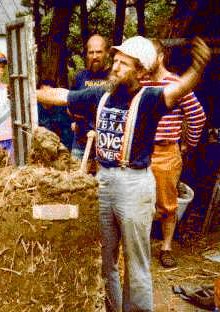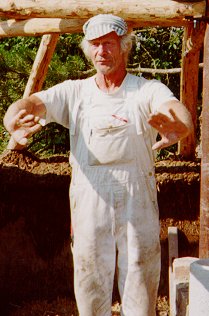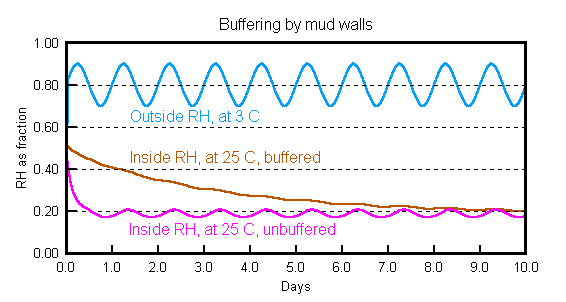
 |
Casting mud in the debate on museum environmental standards |
Last year (1997) I took a summer break to help build a mud house. We used the very latest techniques for trampling clay, sand and straw with bare feet, controlling the quality of the material by how it stuck to our toes and timing how it settled after shaking in water. We debated the relative merits of different cereal straws and finished off the day's labour with song and gossip round the fire before retiring to our tents of polyester fabric, kevlar rope, carbon fibre rods and silicone waterproofing.

 Before getting to the point hinted at in the title to this piece, I must say a word in appreciation of the leaders of this anachronistic/futuristic exercise. Ianto Evans of the Cob Cottage Company of Oregon has a web site that you should visit if you are interested in cheap housing and a long tussle with the authorities who control how those in a free country may build. Flemming Abrahamsson runs a small company in rural Denmark, thatching and making stoves and eco-toilets.
Before getting to the point hinted at in the title to this piece, I must say a word in appreciation of the leaders of this anachronistic/futuristic exercise. Ianto Evans of the Cob Cottage Company of Oregon has a web site that you should visit if you are interested in cheap housing and a long tussle with the authorities who control how those in a free country may build. Flemming Abrahamsson runs a small company in rural Denmark, thatching and making stoves and eco-toilets.
Ianto, on the left, is explaining how to embed a window as the wall is built. Flemming is on the right
I made some tiles from sand, clay and straw. These were air dried and then put to the test as a humidity buffer for museums, or anywhere else.
Mud works well. In the graph below the blue line is the outside relative humidity (RH) at 3 degrees celsius. The purple line is the RH of a room at 25 degrees, with one third of an air change per hour, and with no absorbent surfaces. Its starting RH is 0.5 (50%). The brown line is the same room with 30mm of mud on the walls.

The graph shown above is a computer simulation, based on a much shorter period of measured results from a climate chamber.
The qualities of mud as a building material have been appreciated by ordinary people for millenia; they had little choice. Now researchers are beginning to translate this 'feel good' factor into physical constants quoted in SI units to many decimals, so maybe there is some chance that we will soon be making public buildings out of the stuff that sticks to our boots.
There are many building materials that are porous and water absorbent in varying degree. In recent times this property has been disregarded, or even viewed as a disadvantage, allowing condensation and damage within the wall. A subtler analysis shows that porosity can in fact prevent condensation damage. This analysis is particularly relevant to museum design in temperate climates, where the interior air is often humidified in winter.
The pore structure of an earth wall is shown in the next chapter and compared with the structure of cellular concrete, which is a modern industrial material with similar moisture absorbent properties.
The Cob Cottage Company, Box 123, Cottage Grove, OR 97424, USA. Web link lost at 2014.
Fornyet Energi is at: Øbrovej 9, DK-4295 Stenlille

This work is licensed under a Creative Commons Attribution-Noncommercial-No Derivative Works 3.0 License.